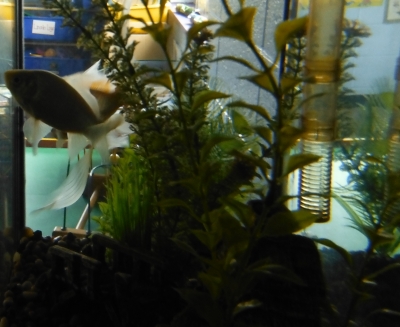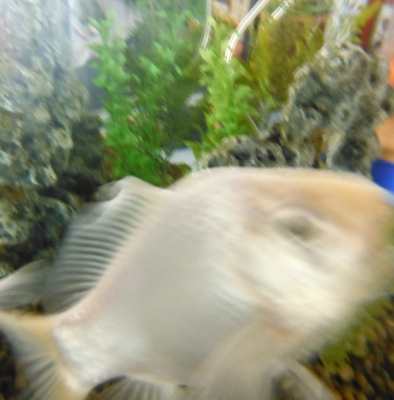Now that you have your gravel and your plants and decorations ready to go, take them all over to where you have decided to set up your tank, but before you put in even one drop of water, I want you to play a little game with me called “Let’s Clean the Tank.” In this game we get to act like preschoolers and do a lot of pretending. Stay with me now, because this isn’t as crazy as it sounds. Once you put all of the necessary items and water into your tank, you aren’t going to be able to move your aquarium without taking everything out again, including the water, so this is actually an important step of the initial set up of your goldfish home.
Grab whatever tools you will be using to clean your tank and pretend to do the cleaning. Get that vacuum to the bottom and move it around the imaginary gravel, “clean” all four sides of the tank, pretend to change and check the filters, and pretend to plug them in. Were you able to do everything without too much trouble? Was it hard to reach the back of your tank? Did the filter get caught between the tank and the wall? If any part of the tank was hard to reach, you might want to think about moving things around a little. Make sure you can reach every area easily. If everything is accessible, you are ready for fish “furniture” and decoration.
Once you have washed out the inside of your tank, you are ready to add some water. Water anywhere is okay for use, but if you are using city water, you must add a chlorine remover or the water must be left to stand for at least 24 hours so that the chlorine disperses completely. Fill the tank tank 1/3 of the way with water, and put the gravel in next. Pouring water in last stirs up too much debris, even if the gravel has been washed, and especially once the tank is established.

A long shot of my tank, showing the perspective that my fish have as they swim from one side to the other.
Tank Set Up
Now we have come to the fun part! You get to be the moving company and interior decorator for your fish Most people with aquariums slope their gravel so that there is a taller pile of it in the back and a smaller pile of it in the front. You won’t do this if you have an under gravel filter, but if you are using above gravel filters it is a perfectly acceptable, and often preferable, practice. Not only does it give your fish the uneven depths that they would find in the wild, but it helps you in cleaning. Anything dropping to the bottom of the tank will eventually roll to the front, making it easier to make quick vacuum runs more frequently, though you should regularly vacuum your entire aquarium when needed. Sloping the gravel this way also displays your items at different levels, meaning that you can see more of what you have planted or placed inside, increasing the aesthetic appeal for anyone viewing your fish.
Putting plants and decorations in before the gravel guarantees that they are in a secure place, on a flat surface with the weight of the gravel holding them down. Putting plants and decorations in after means they are easier to move around. Whichever way you choose to add your decorations, make certain the objects are stable enough that when your fish swims around them, they do not become trapped or caught in something that falls over from their movement.
Typically, taller plants go to the back and smaller plants are placed forward. You want a balance with plant placement; something that gives your fish a feeling of safety, but also displays as much of your tank as possible for anyone who has come to view it. Too many large plants at the front will also block the light that enters your fish tank from the room. One larger plant blocking an intrusive light would be acceptable, if the rest of the tank were allowed to have light entering freely. In my setup, I have all of my large plants in the back and one specifically blocking some of the light that comes from the window. I prefer to give my fish access to a minimal amount of natural light by placing my tanks with one small fraction of their surface so that it gets early morning sun. This wakes the fish in a natural way before I come barging in, flicking on light switches and literally pestering the poop out of them.
I’m not going to give you a map of where to put your plants, air producers, rocks, floating toys, or anything else that you decide to use for your landscaping. That is all up to your personal aesthetics, just look at what you have, play around with your setup and find something that looks appealing to your eye and will be stimulating to your fish. Give them a place to hide, but don’t smother them so much that they can’t move or be seen. Believe it or not, once your fish feel settled in your household, they will actually WANT to interact with you. My Nix and Hydra actually get upset if we are across the room from them for too long and begin spitting and knocking things around to get our attention. Fish are schooling animals and you will become part of their school in some way or another, especially with goldfish, who are more intelligent than most people give them credit for.

The gap between the air stone and large plants behind it provides Nix and Hydra with shelter and casts shadows when the sun shines in for a few hours each morning.
Once you have everything just right, you can fill the tank the rest of the way, turn on the filtration systems… and hurry up and wait. Yep, I said wait. It is much too stressful for your fish to be suddenly dumped into a freshly created environment, no matter how well you have cleaned and prepared it. Imagine having a giant snatch you up and without warning, drop you into his massive Jacuzzi. Sure you could get used to it eventually, but I bet you’d be in a little bit of shock for a while before that happened.
Give the filters a chance to settle any tiny particles that you missed and naturally adjust the pH and temperature. Make sure the water coming out is as close to the surface as possible. It should be a water flow, not a water fall. When you have let everything run for 24 hours, it is safe to get some bacteria into your tank. This is the good stuff that comes from gravel in a tank that is already established. You only want a handful of this gravel and you will place it in with your own. If the gravel is different and you don’t want it to stand out, you can bury it in a pile under what you already have. If it is a safe size for your fish, and if you are happy enough with its appearance, you can mix it right in.
Because I have kept tanks for so long, I have rarely needed to go to an outside source for this step, but if you have no idea where to turn for this, ask the store where you buy your fish. I prefer to get some gravel and plenty of extra water from the tank that the fish were in at the store. Theoretically they are used to this bacteria already and you are not introducing anything new, like illnesses, that could have come from other tanks. If you have picked out healthy fish from a healthy aquarium, the handful of gravel you get for them should be just right.
Introducing Your Goldfish
Once all of this has been done, you can introduce your goldfish into your tank. Moving in is one of the most serious parts of goldfish care. This is the easiest way to transfer diseases, shock your fish into illness, or worse. The first week in their new tank is when your fish are the most vulnerable. When you bring your fish home from the store, ask the clerk to double or triple bag them and keep your fish in those bags until you get them into your house. Remember that in that tiny bag they have nowhere to go and no way to protect themselves from the intensity of the sun.

No education here, just fun as Nix photobombs my underwater camera.
We all know the trick about floating your bag in the established aquarium water so that the water in the bag slowly becomes the same temperature as the water in the tank. What most people do after that is cut a hole in the bag and dump the fish into the tank. It is important to remember the bacteria levels in the water will not be the same as those your new fish has experienced in its previous home. It is very necessary to help your fish adjust to this new chemistry in a healthy and stress free way. To do this, open the bag carefully and add a cup of the aquarium water to the bag. Close the bag and let your fish adjust to that new bacteria and chemical balance for a good 10 minutes or more. Open the bag again, remove one cup of the water from the bag and dump it out in the sink, into a bucket, into your plant, anywhere EXCEPT into the fish tank, then add another cup of water from the tank into the bag, close and wait some more.
Once you have waited a total of 20 or 30 minutes for both of these water changes, pick up your fish net, hold it over a bucket or some other container, and gently pour your goldfish into the net, letting the water drain out and be collected in the bucket below. (I do NOT suggest doing this over the sink or plant because if your fish gets frisky, you don’t want it in the drain, or flopping around in the dirt.) Why are you doing this instead of dumping the bag into the tank? If there are any diseases in the water from your store, they will go into the bucket and you have severely minimized the risk of transferring these illnesses to your aquarium. You can now put the net into the tank and let your new fish swim happily into its established home. These steps should be taken any time you move a fish from one aquarium to another, even in your own home.
Now you can settle down and enjoy your new family members. You might think this is the end of my fish keeping lesson, but it is really only the middle point in your journey through goldfish care. If you can’t wait to read my next post on feeding and behavior, I highly recommend getting the book, Goldfish: A Complete Pet Owner’s Manual by Marshall E. Ostrow. I have used this book as a reference many times in the past and continue to use it as a reference for this series of posts.

Mirrani Houpe, our Small Animal Editor, has had rats since she took home her first little boy once they both completed the second grade. Since that time she has owned, rescued and bred many kinds of rats, from many backgrounds. She may not be a vet, psychology major, or scientist, but her babies have her very well trained when it comes to how to care for them. She is constantly working with her family’s veterinarian to come up with new and innovative ways to love and care for the most often misunderstood rodent in the pet world. You can e-mail her at mirrani@yourpetspace.info
